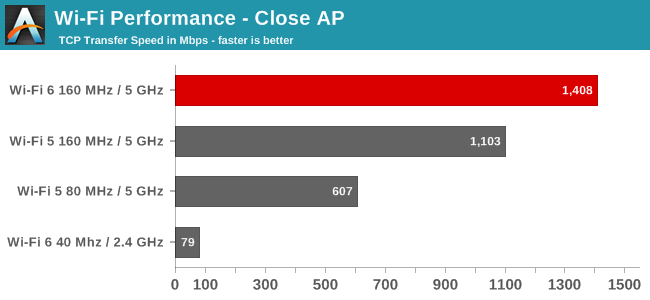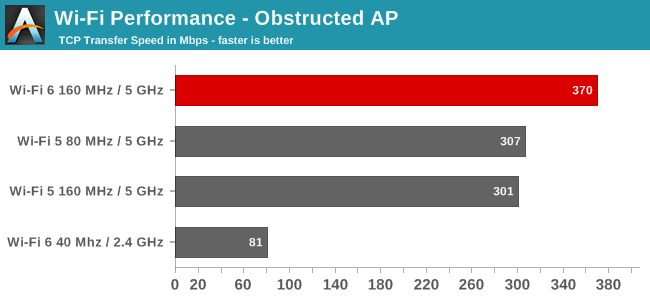AT 101: Wi-Fi 6 And Why You Want It
by Brett Howse on February 12, 2020 8:00 AM ESTPerformance
In order to achieve maximum performance, the latest Wi-Fi 6 standard leverages 1024-level QAM, but depending on the signal strength and quality it will scale down as needed, so to achieve the best performance very high signal to noise ratios are going to be required. Since 5 GHz is attenuated dramatically when it has to go through walls, if you need maximum Wi-Fi performance be aware that you are going to want your wireless router as close to the end device as possible. Luckily that is not an issue in our case, since the router is in the same room when testing for maximum performance, but we’ll also evaluate it in less than ideal scenarios as well.
Wi-Fi 5 vs Wi-Fi 6 – Close AP
First up we’ll test the TCP performance when the Access Point is in the same room as the client.

The performance advantages of Wi-Fi 6 are clear. With the access point in the same room, the SNR is very good and the new 802.11ax standard can really shine. With 1024 QAM and 160 MHz channels, the performance is over twice as fast as the outgoing Wi-Fi 5 with 256 QAM and 80 MHz channels. It is very impressive to see a typical 2x2:2 connection well over the Gigabit barrier, and even though the AX200 network card is the first generation, Intel has already done a fantastic job tuning it. The theoretical maximum transfer rate with 160 MHz channels and 1024 QAM is around 1200 Mbps per connection, so a 2x2 can in theory hit around 2.4 Gbps, meaning there's still room for improvement. Since 802.11ax also can be used on the 2.4 GHz frequency, unlike 802.11ac, the same test was also done on 2.4 GHz, and the results were disappointing. 2.4 GHz can still offer 40 MHz channels, but it doesn’t seem like the AX200 could take advantage of any of that. For reference, the wireless adapter in the laptop was reporting -21 dBm, which is a strong signal, which makes sense since the AP is almost right next to the laptop.
Wi-Fi 5 vs Wi-Fi 6 – Reduced Signal
Moving the laptop further away, and adding several walls and doors in the way to attenuate the signal, the same scenarios were again tested.

With some walls in the way, 5 GHz gets attenuated quite dramatically, and the SNR in the second location was -78 dBm. With such a low signal, the Wi-Fi 6 connection wasn’t able to take advantage of the 1024-level QAM and would have had to drop down to a much lower set, reducing the number of bits per tone, and even though the total channel bandwidth was still 160 MHz, it was only marginally faster on 802.11ax than 802.11ac 80 MHz. 2.4 GHz is not as impacted by walls, and as such was able to maintain the same transfer rate, even though it was still quite a bit slower.
So the results are clear. Wi-Fi 6 can offer a significantly higher level of throughput than Wi-Fi 5, but in order to do so, it needs a strong signal. The Wi-Fi 6 still outperformed the Wi-Fi 5 in the second test with an attenuated signal, but the performance gain was minimal. 2.4 GHz still offers the best signal strength, and therefore would be able to connect further away, and through more obstacles, but doesn’t offer anywhere near the performance of the 5 GHz range. It will be interesting to see the Wi-Fi 6E devices with 6 GHz support when they launch. It will open up Wi-Fi to a wider set of frequency choices, but will offer even less range.










149 Comments
View All Comments
Mccaula718 - Wednesday, February 12, 2020 - link
Why is the WAN port only 1 Gbps?5080 - Wednesday, February 12, 2020 - link
You can always combine a WAN and LAN port into dual WAN to double the throughput. I have an ASUS RT-AX88U connected to an ARRIS SB8200 with Link Aggregation to take advantage of a 1.2Gbps internet connection.Makaveli - Wednesday, February 12, 2020 - link
Sounds like you are on a 1Gbps cable connection why bother with Link Aggregation?do you actually see the slight over provision on the connection?
deil - Wednesday, February 12, 2020 - link
at my place you can get either from 250/50 Mb/s to 1000/50 Mb/s from anyone that is quite cheap or 3000/500 from one for insane price (~20x more).I am planning for now to use that for both reliability of the uplink (I know ISP's use different nodes when they leave my place) and faster bandwidth (I have fiber to my place and cat 6 (5GB/s) internally.
5080 - Wednesday, February 12, 2020 - link
It peaks at about 1.1Gbps on LAG and 0.85Gbps on one.Dug - Wednesday, February 12, 2020 - link
1Gbs outside may actually be 1Gbs. Inside 1Gbs isn't 1Gbs because of overhead when you have multiple connections. So with aggregation you can benefit multiple connections going outside.azfacea - Thursday, February 13, 2020 - link
this is getting really ridiculous. wired lan is going from "slower" than wifi to "much slower" than wifi. If aliens came down to earth i am not sure what they would think of this lunacy.zshift - Thursday, February 13, 2020 - link
This isn't the case. 2.5Gbps and 10Gbps Ethernet has been out for a while now, it's just not propogating to consumer hardware because it isn't needed in most scenarios. Ethernet can maintain these high data rates over very long distances. This article showed that even wifi 6 across a few rooms drops to below 500Mbps. Higher wifi speeds are needed in order to compete with Ethernet over a long distance, but it's still far more stable (though not easier) to drop Ethernet throughout your place to get near 1Gbps with older routers.RadiclDreamer - Friday, February 14, 2020 - link
10gb, 25gb, 40gb and 100gb are commonplace in the business space, they just havent filtered down to consumers due to lack of demand.Keep in mind also that wifi is simplex (or half duplex) meaning that it can only send or receive but not both at the same time. You also have a lot of overhead on wifi that leads to these numbers not being as good in practice as you might think. Take a normal AC router for example, and lets say you are connected at 867mbps, thats for the entire link, not just the payload. You have WPA2 overhead, errors, retransmitted frames, interference with your neighbors/other devices, TCP/IP overhead (which is present on ethernet also) to contend with and you are going at 1/2 duplex. All of this together means that you are going to actually see about a 400mbps connection for payload.
This is not to snub wifi, its getting very good very fast. But to say that it even comes close to competing with a hardwired connection is just not understanding the technology and whats out there.
Makaveli - Friday, February 14, 2020 - link
Wifi being half duplex only applies to everything Pre Wifi 6 (AX).AX is full duplex.